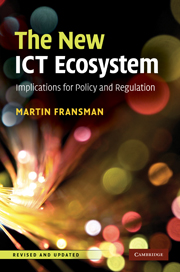Book contents
- Frontmatter
- Contents
- List of exhibits
- Preface
- List of abbreviations and acronyms
- Introduction
- 1 Summary of the argument
- 2 The new ICT ecosystem: architectural structure
- 3 The new ICT ecosystem as an innovation system
- 4 The new ICT ecosystem: a quantitative analysis
- 5 Telecoms regulation
- 6 Policy-making for the new ICT ecosystem
- 7 The way forward: the message to policy-makers and regulators
- Appendixes
- Bibliography
- Index
7 - The way forward: the message to policy-makers and regulators
Published online by Cambridge University Press: 04 May 2010
- Frontmatter
- Contents
- List of exhibits
- Preface
- List of abbreviations and acronyms
- Introduction
- 1 Summary of the argument
- 2 The new ICT ecosystem: architectural structure
- 3 The new ICT ecosystem as an innovation system
- 4 The new ICT ecosystem: a quantitative analysis
- 5 Telecoms regulation
- 6 Policy-making for the new ICT ecosystem
- 7 The way forward: the message to policy-makers and regulators
- Appendixes
- Bibliography
- Index
Summary
It is widely accepted that the ICT sector is of key importance in all economies. It makes a major contribution to productivity, economic growth and employment and provides the information and communications infrastructure without which, in the modern world, the economy will not function. However, the ICT sector is itself undergoing radical change, largely as a result of the evolution of the Internet which began to be widely diffused only from around 1995. The evolving Internet has created added complexity in the ICT sector. For example, it has incorporated and transformed previously unrelated sectors, such as media, into the ICT sector; it has created new groups of key players in this sector – such as Internet content and applications providers like Google, Yahoo!, eBay, Amazon and MySpace; and it is transforming consumer interaction and behaviour in fundamental ways. In this book the phrase ‘new ICT ecosystem’ has been used to encapsulate these changes.
It is suggested here that in order to understand the ICT ecosystem it might be useful to conceptualise it in terms of a number of hierarchically structured modularised layers that together constitute a functioning system. The four-layer model proposed here for this purpose includes the networked element, the converged network and the platform, content and applications layers as well as, lastly, the final consumer layer. The major part of this book is devoted to an analysis of how this ecosystem works.
- Type
- Chapter
- Information
- The New ICT EcosystemImplications for Policy and Regulation, pp. 102 - 106Publisher: Cambridge University PressPrint publication year: 2010



